With coaches like Kerr, Carroll and Maddon, pro sports teams remember to have fun – CBSSports.com
The rigors of the long season were starting to get to the
Golden State Warriors
. Back-to-backs, cross-country flights in the middle of the night, the mental and emotional toll of staying sharp through a seemingly endless season — all of these factors were wearing down the winningest team in the league.
That’s when Steve Kerr and a couple other members of his staff got an idea: Let’s mock the hell out of Luke Walton. Walton was Kerr’s top assistant, a rising star in the coaching world who would go on to become the
Los Angeles Lakers
‘ new head coach in April 2016. He’d won multiple championships as a player, and held additional status within the game as the son of one of the greatest players of all time.
On this day, nobody cared. Seeking to snap his team out of its malaise, Kerr ordered the team into the video room to watch some important film: Walton’s devastating acting performance on “The Young and The Restless.”
“It was horrible!” laughed Kerr in a recent phone conversation. “We put it on, and to Luke’s credit he didn’t care, he was very comfortable in his own skin. The big thing was it really lightened mood in practice that day. We try to make things entertaining and loose, while still working on the fundamentals every day and competing every day.”
Kerr is one the most prominent advocates of something which a generation ago might have seemed like a novelty in sports: preaching the idea of fun. The grind of a long season, the pressure of playing in the spotlight, the close quarters players must keep with each other for six months or more … all of these can create tension, mental fatigue, and conflict. By making fun a central tenet of their locker room culture, Kerr — along with leading fun advocates like
Chicago Cubs
manager Joe Maddon and
Seattle Seahawks
coach Pete Carroll — believe they can unlock a competitive advantage that’s tough to quantify, but still real.
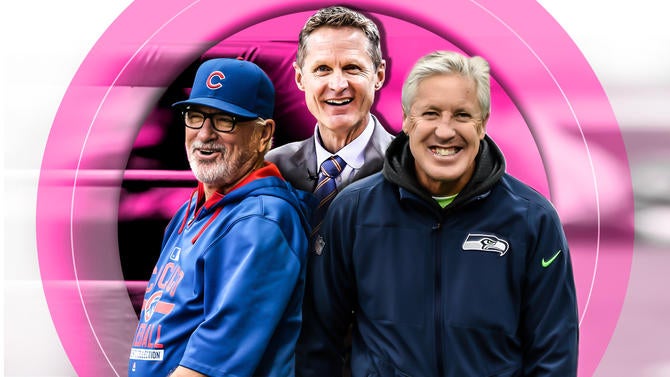
The origins of Kerr’s flight to fun start in his playing days. A sharp-shooting guard, Kerr played five seasons in Chicago under Phil Jackson. Known for his fervent support of practices such as meditation and yoga, Jackson found plenty of other ways to connect with his players too. Like other teams, the
Chicago Bulls
put in plenty of hours in the film room, dissecting other teams’ tendencies. But Jackson would sprinkle in clips from classic comedies to liven the mood, finding the right moments from “Caddyshack” or “Animal House” based on the specific challenge that night’s opponent presented. Imagine the wacky, lovable science teacher who used to blow stuff up in class, Kerr says — that was Jackson.
After his run in Chicago, Kerr spent four of his final five seasons playing for the
San Antonio Spurs
. San Antonio’s coach Gregg Popovich has long projected a crusty demeanor on the sideline and during his notoriously short and grouchy in-game interviews. But Kerr praised both his future Hall of Fame coaches for knowing how to get the most out of their players.
“Pop had this great sense of humor. With him the days were fun,” Kerr said. “Both Phil and Pop were interesting human beings who really cared about their players. They both created a balance between discipline — getting work in everyday — and fun. It can’t just be a summer camp run wild where you do whatever you want. There was always some structure behind it too. But I always thrived best in those situations when I enjoyed myself.”
Watch the Warriors practice, warm up for games, or splash threes against helpless opponents, and you’ll see all of that fun in action. There’s no scenario in which Steph Curry will ever need to launch a 3-pointer from the edge of an arena’s tunnel, which makes practicing that shot analytically useless. But it’s part of the two-time MVP’s pregame ritual, it gets the crowd fired up, and hell, he’s damn good at it. Bombs away.
When the Warriors recruited
Kevin Durant
in the wake of their heart-breaking loss in the NBA Finals, they had plenty of ammunition at their disposal. First, they could offer a loaded roster, one that had won two straight Western Conference titles, nearly won two straight NBA Finals, and boasted arguably the best player in Curry. Second, Golden State’s unselfish, fast-paced, spread-the-court style of play fit Durant’s game absolutely perfectly. But when Sports Illustrated writer Alex Kennedy asked
Draymond Green
how he helped convince Durant to join the team, Green had a simple reply.
“I mean, I was really just telling him about the fun we have together,” he said.
When it comes to contemporaries, the coach Kerr cites as his biggest influence actually comes from another sport: Pete Carroll. A well-regarded assistant coach at the college level for a decade, Carroll cracked the NFL in 1984 as defensive backs coach with the
Buffalo Bills
. A decade after that, he won the coaching job with the
New York Jets
. Carroll quickly earned a reputation as an enthusiastic leader. Urging both his players and assistant coaches to have fun, he rolled out many ideas that had nothing to do with football: bowling outings, cookouts with players, three-on-three basketball games with his fellow coaches in the parking lot of the team’s practice facility.
Carroll’s critics weren’t impressed. When the Jets went 6-10 in his first season, that also became his last, as the team fired him at season’s end. When the
New England Patriots
went from 10-6 to 9-7 to 8-8 in Carroll’s first three seasons in Foxboro, he was dismissed again. By the end of that three-year stretch, the team had roster problems and talent shortages that might not have been solvable by any coach. But the perception remained the same: Carroll’s drive to create a fun atmosphere made him too soft to be an NFL coach — doubly so in hard-edged East Coast markets, triply so when he took over for noted hard-ass Bill Parcells with the Pats. Talking to the San Francisco Chronicle in 2000, Carroll admitted that his approach was never going to resonate everywhere. “I think I fit better in other places,” he said.
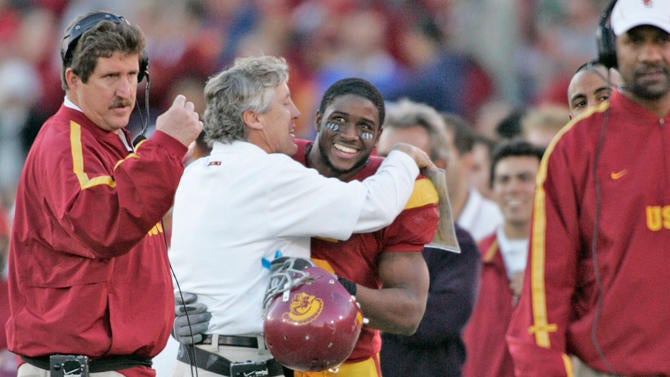
One of those places turned out to be Los Angeles, specifically back at the collegiate level at USC. After winning the job at Southern Cal only because the Trojans’ first three choices all fell through, Carroll quickly resurrected one of college football’s traditional powerhouses. His enthusiasm jumped out at you on the practice field, on the recruiting front, and on the sidelines in the Coliseum. Practices were rowdy affairs, with music blaring the whole time, and a by-now over-50 Carroll sprinting the sidelines and sticking his nose right in the middle of drills. Led by Carroll and ace recruiter Ed Orgeron (and also multiple recruiting violations) the Trojans for years reeled in many of the top recruits in the country. Gameday was electric, not just because of the heroics of outrageously talented players like
Reggie Bush
, but also the three-hour smile plastered on Carroll’s face every Saturday.
“I visited him a couple months before training camp of my first year,” recalled Kerr. “And I just learned so much from him. I loved watching those
Southern California Trojans
teams. They were fun, but also so disciplined … but so fun.”
Though skipping town amid that recruiting scandal didn’t look great at the time, Carroll did go on to prove his critics wrong, successfully shifting his approach from college to the pros. Promoting the same mix of fun and hard work to his players, he led a loaded Seahawks team to the first Super Bowl victory in franchise history in 2014.
For Carroll and later Kerr, a thin, 134-page book called “The Inner Game of Tennis” by Timothy Gallwey encapsulated much of what they would teach their players. Though not a fun manual per se, Inner Game taught Kerr that “the most important thing is to get out of your own way.” That inner voice that yells at us when we mess up, in sports or in life? Take control of that voice, and make it stop yelling. In Kerr’s case, he learned a fun way to squelch that inner doubt, a method he will sometimes bring up to players who come to him in moments of uncertainty.
“In the book, the idea is that you take a practice session and pretend you’re one of the world’s best tennis players, instead of yourself,” said Kerr. “So for me, when I was in Chicago, I would go to practice and I would be Jeff Hornacek, not myself. He was a way better player than I was, with lots of tricks, hook shots. I was very conservative as a player. But I started pretending to be Hornacek, I started taking more chances.”
To Kerr, the broader message he conveys to his Warriors team is simple. “Don’t take yourself so seriously! We make fun of each other, make fun of ourselves, let the players make fun of us. It’s just a game!”
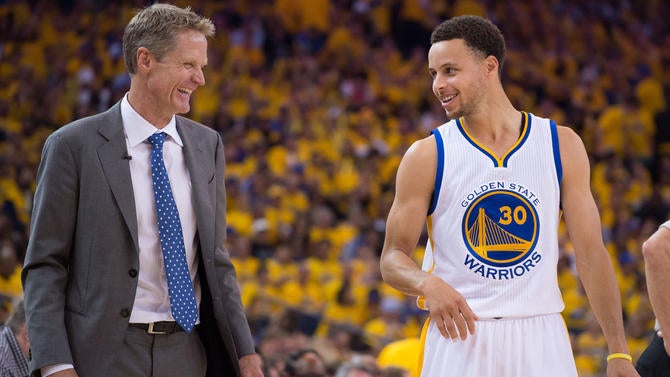
While Kerr and Carroll win trophies through the power of fun and positive thinking, it’s easy to forget how recently the opposite track was the one that many sports fans and media members revered.
Dick Williams was a two-time World Series winner and four-time pennant winner, one of the savviest managers in baseball history, liked by many of his players, and eventually a Hall of Famer. He could also be frighteningly cruel to players he didn’t like. He would constantly question the toughness of his ace starter with the Montreal Expos, Steve Rogers — despite Rogers firing 301 2/3 innings in Williams’ first season in Montreal. When an excruciating bone spur grew so painful Rogers couldn’t even lift his arm above his head (and forced him to miss the end of the 1978 season) and a poorly prescribed rehab approach led to brutal shoulder pain, Williams didn’t offer any sympathy. On the eve of the next year’s spring training, one of the Expos coaches asked Rogers how he was feeling.
“My elbow feels great, but my shoulder is killing me,” Rogers replied.
Unimpressed by Rogers’ All-Star pedigree and massive annual workload, a drunken Williams sneered. “Well, if you can’t f—— pitch, then we’ll get some-f——-body else.”
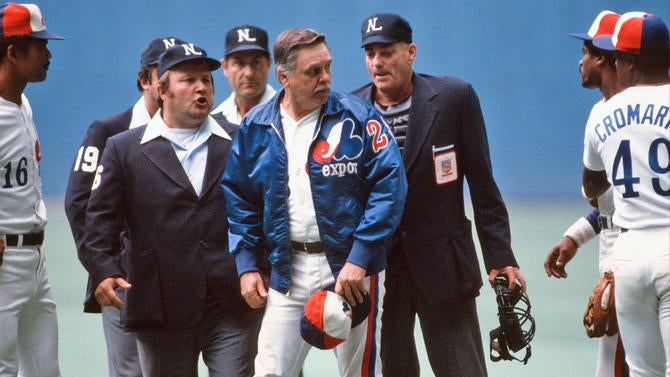
Williams could be combative, and he certainly drank too much. But he was an angel compared to Bobby Knight. Like Williams, Knight was one of the most successful coaches of his generation, leading his
Indiana Hoosiers
University Hoosiers to three national championships. He too recruited plenty of talented athletes to his school, and earned praise for developing many of those athletes into elite players.
He was also one of the nastiest human beings to ever coach any sport. You could maybe defend Knight throwing his chair across the court as a sign of protest against a referee that got out of hand but didn’t actually hurt anyone. What no one can defend is the way Knight frequently treated his players. The abuse ranged from constant verbal tirades to an enraged Knight choking former IU guard Neil Reed in the middle of practice.
Kerr doesn’t believe we’ll see another Bobby Knight any time soon. For basketball in particular, he sees AAU culture supplanting old-school high school culture, where the high school coach is no longer “worshiped” like he once was. If an AAU coach berates a top prospect, he can just move to another town, and another team. And in the age of social media, Knight and his surrogates wouldn’t be able to sweep his misdeeds under the rug — they would become amplified, and in the case of something like the Neil Reed incident, become media firestorms that could cost him his job.
“It can’t be my way or the highway anymore,” Kerr said. “You have to collaborate. You even need to be more entertaining. Attention spans are getting much shorter. And I’m not saying, ‘In my day, we focused better.’ It’s me too, I focus less now than I used to, with my iPhone. I believe that’s a factor too. Coaches have had to adapt and change. As a result they’re getting better.”
Growing up playing high-level baseball and football (plus some basketball) in Hazleton, Pennsylvania, Joe Maddon never experienced a coach as unhinged as Knight. Still, playing for one particular coach, Maddon experienced the opposite of joy, and the dread that came with it.
“I had a coach who was a screamer and a yeller,” recalled Maddon before a recent Chicago Cubs game at Wrigley Field. “He made you lose sleep. When you made a mistake, you felt like you wanted to cry on the sideline.” Walking into the locker room, “you felt some absolute heaviness walking in that door. Wow. You’re playing since you’re 6-years-old, then all of a sudden you walk into this place you’ve always wanted to be, and you don’t want to be there.”
Maddon never wanted to be that guy. He vowed that if he ever got to coach or manage, he would be the guy who didn’t yell when a player made a mistake. Instead, he would use player mistakes as opportunities to calmly and encouragingly offer a better approach that could work in the future. More than just an absence of negativity, Maddon sought to create a positive clubhouse environment which could help his players flourish.
Much of that effort involved spirited study of leadership skills, and psychology. Maddon took cues from more seasoned colleagues, including Gene Mauch and Terry Collins. He devoured books on the art of motivation and leadership. When Maddon took over the Cubs job, he brought in Dr. Ken Ravizza, a highly regarded sports psychologist with who’d worked with Maddon one-on-one for years when the skipper ran the
Tampa Bay Rays
.
Still, a lot of it boils down to nothing more than Maddon encouraging players to be themselves, and to have fun. Instead of the same, boring, old procedures for road trips, he’ll encourage players to wear wacky suits, short shorts, or whatever else fits with that week’s theme. He’ll liven up (and/or terrify) the clubhouse by bringing in a 20-foot python. During spring training mornings, he’ll have a guitarist playing riffs that boom throughout the entire complex. After every regular-season and playoff win, they’ll put up a disco ball and smoke machine, turn off all the lights, and hold a rager of a dance party. Whatever it takes to make players loosen up, enjoy themselves, and make it through the rigors of a long season, Maddon’s willing to do it.
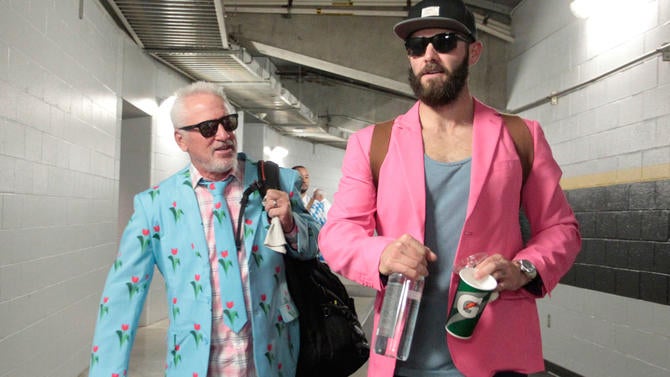
“If it’s going to wear you down, if it’s going to make you wary, then why would you want to do it? So it’s got to be fun,” Maddon said. “I ran instructional leagues in the 80s in Arizona. We ran “special Olympics”, where we had different events. Devon White winning a jumping contest. Fungo contests — Devo hit a fungo from home plate over the center-field batter’s eye; that’s 400 feet, he just flipped it up and bam! We had a 60-yard dash against a Weimaraner … of course the dog won every time. We had to line up on a line, and there would be shoe inspection. Frank Greenberg would do that and make everybody laugh. We would have a joke of the day. That would always get you going. It was just a lot fun, every day. I have not done one thing in my life that I haven’t had fun doing.”
When it comes to picking a place to play, Maddon’s players stop short of calling fun a deciding factor. They list joining a winning team and finding the right city as more important factors, and of course money plays a big role too. Also, you can’t know for sure how enjoyable it might be to play for a particular team until you get there (though Maddon’s fun-loving reputation, and the fun that players had in Tampa Bay and now Chicago under him, have now spread throughout the league).
Still, for players who do opt to sign with the Cubs, the transition can be both jarring, and exciting.
Veteran left-hander
Jon Lester
had 155 million reasons to join the North Siders, of course. As a
Boston Red Sox
, Lester remembers battling Maddon’s Rays 19 times a year, and yes, sneering at them a bit. While the Sox followed more formal protocols, Rays players would have dressups, skip batting practice, and do all kinds of things that made Lester think, “That’s not professional.”
“Then you get to be a part of it, you get to meet Joe … and now I just love it,” Lester said. “The biggest thing for me was understanding where he comes from and why he does this stuff. Because it is a long season. The word fun gets thrown around a lot. But you want things to be relaxed. You don’t want guys beating their heads against the wall for seven, eight months. So things like having optional batting practice, we’re traveling and we’re going to wear messed-up suits, anything just to break up the monotony of those eight months.
“You spend all this time with these guys and it’s like family. You’re going to have spats and disagreements. So when you have fun things like that, it takes people’s minds off other things. It really helps guys, especially the young guys who don’t have to feel like they’re walking on pins and needles all the time. They can just focus on baseball, instead of whether they’re dressed properly, or if they say something stupid. I think that’s what Joe is thinking about when he talks about the fun aspect of it.”
Like Kerr, Maddon still emphasizes the importance of hard work, and doesn’t see the quest to have fun as an excuse to slack off. Though he doesn’t lay out a list of rules per se, Maddon will bench players for not running hard to first base; that happened several times with
Melvin Upton
Jr. in Tampa Bay. But as long as you don’t disrespect the game or your teammates, you’ve more or less got free rein to do as you please.
For some of his players, that laissez-faire attitude is even more appreciated than some of Maddon’s more colorful hijinks. When asked what Maddon does to set the clubhouse culture, outfielder
Jason Heyward
has a simple reply.
“He really doesn’t do anything,” Heyward said. “He just lets it be. He lets the players express their own personalities, and figures out how we want to go about each day, so that it’s all natural.”
The fun-encouraging ways of Kerr, Carroll, and Maddon, and the success that their teams have had, has caught the attention of other sports teams too. Last month, Toronto Maple Leafs front office staffers Kyle Dubas and Sheldon Keefe attended the International Positive Education Network in Dallas. On a broad scale, the festival aims to teach teachers, parents, academics, students, and schools about the value of encouraging a positive learning environment … often revolving around making learning fun. Long known as a team rooted in old hockey traditions, the festival offered a chance for the Leafs to learn a few new tricks that could prove useful in recruiting and retaining players, and making them perform to the best of their ability.
Why try to change decades of sports tradition? In a word, history. The Warriors’ championship in 2015 was their first in 40 years. The Seahawks’ 2014 Super Bowl win was the first ever for that franchise. The Maple Leafs haven’t won a Stanley Cup since 1967. And of course, the Cubs have the longest championship drought in all of sports, at 108 years and counting.
If draping a giant snake over your players’ shoulders or fantasizing about Jeff Hornacek are what it takes to end that kind of losing streak, then what the hell? Go have some fun.



